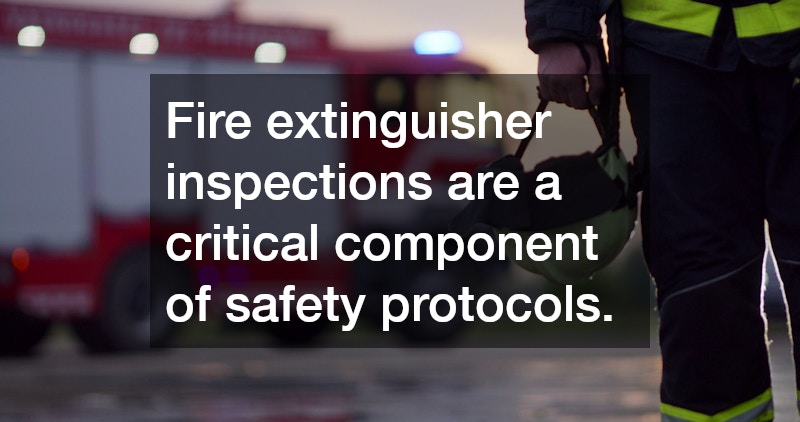Fire extinguisher inspections are a critical component of safety protocols in any establishment. At m fire maintenance services, we understand the importance of ensuring that extinguishers are functional and ready to use, providing peace of mind and compliance with local laws.
Ensuring fire extinguishers are regularly inspected prevents potentially catastrophic situations. Neglecting such a simple, yet vital task could lead to dire consequences in emergency scenarios.
With safety regulations constantly evolving, understanding the importance of compliance is more crucial than ever. Regular inspections can save lives, property, and ultimately reduce liabilities.
What are the regulations surrounding fire extinguisher inspections?
Understanding Local and National Guidelines
Fire extinguisher inspections are governed by both local and national regulations, which are designed to ensure public and personal safety. These guidelines often dictate the frequency and manner in which inspections should be carried out.
For businesses, adhering to these regulations is not just about compliance but also about maintaining safety standards. Most regional fire codes require business owners to be familiar with these stipulations to avoid penalties.
The Role of Regulatory Bodies
Regulatory bodies such as the National Fire Protection Association (NFPA) set standards and guidelines for fire extinguisher inspections. They provide comprehensive instructions on the types, placement, and maintenance of extinguishers.
The NFPA publishes NFPA 10, a document widely regarded as the benchmark for portable fire extinguisher standards. This ensures a consistent approach toward fire safety globally.
How often should fire extinguishers be inspected?
Monthly Visual Inspections
Fire extinguishers should be visually inspected every month to ensure they are accessible and fully charged. These inspections involve checking the extinguisher’s pressure gauge, seal, and overall condition.
Non-functioning extinguishers can be a significant hazard in the event of a fire, making monthly inspections vital. This frequency of inspection helps in spotting potential issues before they become serious problems.
Annual Maintenance Checks
In addition to monthly checks, annual maintenance and servicing of fire extinguishers are mandatory. These comprehensive inspections are often performed by certified professionals who can identify deeper issues.
During these annual checks, extinguishers undergo more rigorous examination, including disassembly, cleaning, and replacement of parts if necessary. Professional checks ensure that extinguishers remain in optimal working condition.
What happens during a fire extinguisher inspection?
Visual Inspections
The first step of a fire extinguisher inspection usually involves a visual check to confirm the extinguisher is undamaged and accessible. This includes assessing the extinguisher for visible signs of corrosion, obstruction, or leakage.
Having clear and legible labeling on the extinguisher is equally important; this information becomes crucial during an emergency. Visual inspections also confirm that the pressure gauge indicates full charge and that safety seals are intact.
These simple yet effective inspections can often be conducted by anyone after adequate training. Employees trained in conducting basic fire safety checks add an extra layer of security within a business environment.
Functional Testing and Maintenance
Functional testing involves ensuring the mechanical components of the extinguisher are operational. This process may include testing the nozzle, hose, and handle to verify their integrity.
Specialized tools are used during these inspections to confirm that the extinguisher’s internal pressure is within safe operating ranges. This detailed testing process often requires the expertise of certified fire safety professionals.
Who is responsible for conducting fire extinguisher inspections?
Business Owners and Managers
The responsibility of fire safety typically falls on the shoulders of business owners and managers. Ensuring that fire extinguishers are inspected and maintained is not just a legal requirement but also a moral obligation to staff and customers.
In many jurisdictions, it’s the employer’s duty to create a safe working environment, which includes overseeing regular fire extinguisher inspections. Failure to do so can result in significant legal implications and disrupt operations.
Certified Fire Safety Professionals
While preliminary checks can be performed by in-house staff, certified fire safety professionals are indispensable for more detailed inspections. They possess the expertise and tools required for conducting thorough examinations and ensuring compliance.
These professionals are trained to identify potential hazards that might be overlooked by untrained individuals. Their services ensure that fire safety equipment adheres to both the minimum safety standards and best practices.
What are the consequences of neglecting fire extinguisher inspections?
Legal and Financial Implications
Neglecting regular fire extinguisher inspections can expose businesses to substantial legal actions and fines. Regulatory authorities impose these penalties to enforce compliance and discourage negligence.
Beyond fines, the reputational damage from non-compliance can be severe, affecting business operations and stakeholder trust. Keeping up with inspection schedules is a preventative measure against such disruptions.
Safety Hazards and Risks
The most significant risk of neglecting fire extinguisher inspections is the danger posed to human life. Malfunctioning extinguishers can render fire response efforts ineffective, escalating what could be a manageable situation.
Besides risking lives, the failure to control fires promptly can lead to substantial property damage. Consistent inspections ensure the readiness and reliability of extinguishers during critical moments.
Regular fire extinguisher inspections play a vital role in safeguarding life, property, and ensuring legal compliance. They act as a frontline defense mechanism against unpredictable fire hazards, offering peace of mind and operational integrity.
Given the profound implications of neglect, businesses and individuals must be diligent about maintaining thorough fire safety protocols. By remaining vigilant, we protect our communities and fulfill our obligations as responsible citizens.
The simple act of instituting regular inspections fosters a culture of safety that resonates far beyond regulatory compliance. It is a call to action for everyone to prioritize fire safety in both personal and professional spaces.





